We’re diving in to five popular Smart Bidding strategies and when to use (or avoid) them for the best results.
Are you finding it challenging to manage every detail of your Google Ads campaigns manually? Bidding on individual keywords and constantly adjusting them based on performance used to be the norm in digital advertising. But in today’s fast-paced landscape, this manual approach has become outdated. With so many variables—such as competition fluctuations and user behavior shifts—staying on top of everything can feel overwhelming.
That’s where Google’s Smart Bidding comes in. By leveraging machine learning, Smart Bidding optimizes bids in real time, and this data-driven approach helps you achieve your goals without the hassle of manual bid adjustments, ensuring you get the best possible results for your budget.
In this article, we’ll explore different Google Ads Smart Bidding strategies, provide examples, and explain when to use and avoid each based on your campaign goals.
Smart bidding is a form of automated bidding. It leverages machine learning to automatically select bids on keywords or placements for you in the Google Ads or Microsoft Ads auctions based on a specific conversion goal. Smart Bidding is constantly optimizing your bids, automatically adjusting them based on factors like competition, device, time of day, and user intent.
There are other automated bidding strategies outside of the four Smart Bidding strategies we’ll cover, like Maximize Clicks or Viewable CPM. These aren’t considered Smart Bidding because they’re focused on campaign metrics rather than campaign outcomes.
The reason why Smart Bidding strategies are “special” is that they focus on your conversion events or conversion value tracking.
💡 Your bid strategy isn’t the only thing in your advertising that can be automated! Download our free guide to powerful ways to use AI in Google and Facebook Ads!
With manual bidding, you have to individually select a max CPC bid for each keyword or placement you’re bidding on. With automated bid strategies, including Smart Bidding, this work is done for you automatically.
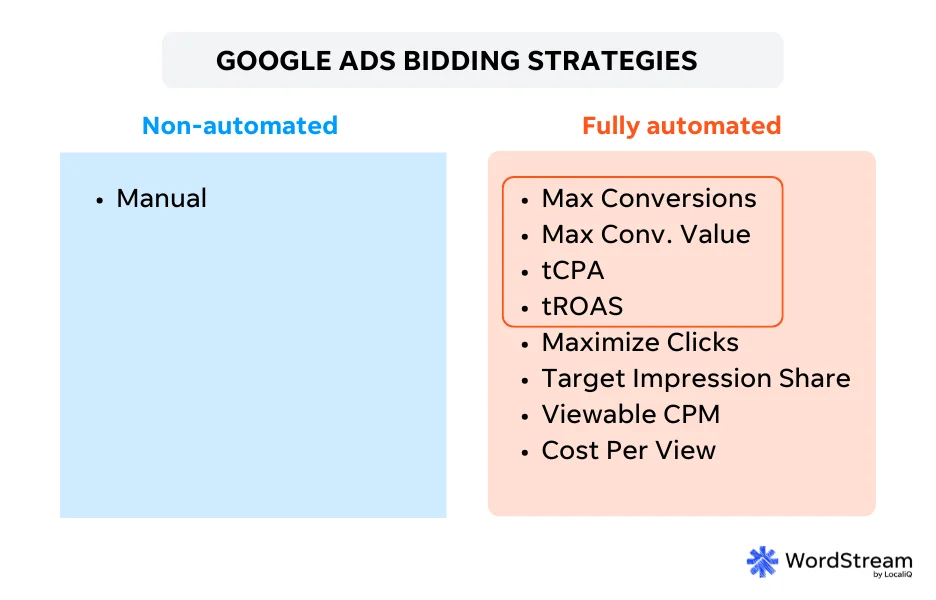
At Google Marketing Live 2025, Google announced the rollout of an extension of Smart Bidding called Smart Bidding Exploration. You can apply Smart Bidding Exploration to any of the strategies we covered above. If you have a Smart Bidding strategy selected, you can toggle Smart Bidding Exploration on or off in its designated dropdown. This allows Smart Bidding to predict how likely you are to convert in each ad auction, even if you haven’t entered these auctions previously, and it may automatically lower or exceed your ROAS targets accordingly.
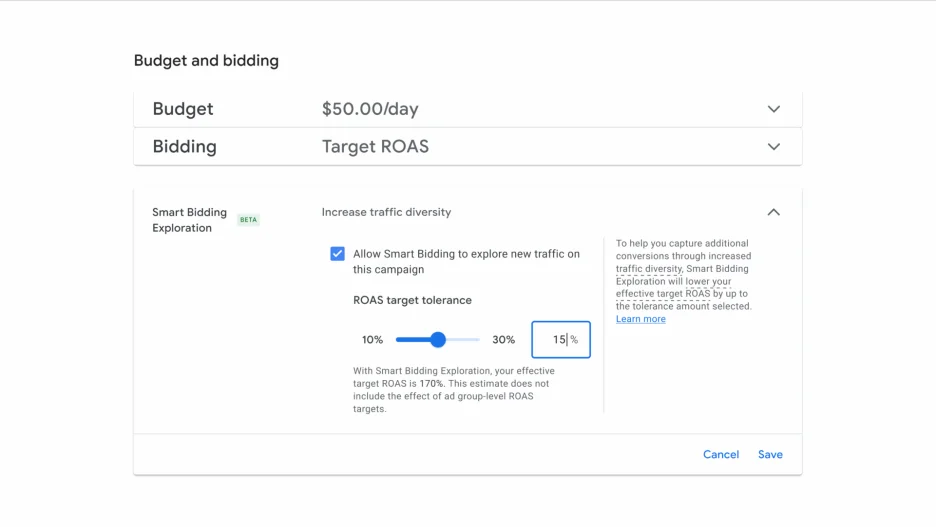
Regardless of your account structure or business size, you’re eligible to use Smart Bidding. Let’s look at some of the benefits:
Smart Bidding…
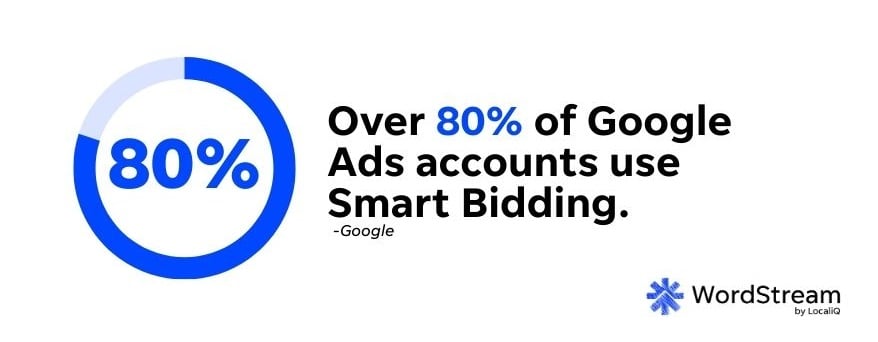
Here are the four Smart Bidding strategies to help you get more out of your budget and what you need to know about each. Let’s dive in!
Target ROAS (Return on Ad Spend) aims to generate the highest possible return on your ad spend by automatically adjusting bids based on the predicted value of each conversion.
This strategy optimizes bids to focus on conversions that drive the most revenue rather than just increasing the number of conversions. It’s ideal for businesses looking to prioritize revenue generation over conversion volume.

Important note: You can’t simply set a high ROAS target and expect to hit it if you haven’t achieved similar performance in the past. Google Ads will suggest a ROAS target based on your historical data. When setting your target ROAS, it’s crucial to choose a realistic goal that aligns with your past performance.
For example, if Google suggests a ROAS target of 300% based on your past results, this means for every $1 you spend, the goal is to generate $3 in revenue. By setting this realistic target, Google Ads will adjust bids to maximize the likelihood of hitting or exceeding that target consistently.
When to use it:
When to avoid it: If you’re unsure about the value of each conversion or have a low volume of conversions, it may not perform as expected.
🛑 Worried you’re wasting spend in Google Ads? Find out with a free, instant audit using our Google Ads Performance Grader.
Target CPA (Cost Per Acquisition) sets bids to help get as many conversions as possible at or below your specified target cost per acquisition.

Important note: Similar to ROAS, you can’t simply set an arbitrary CPA target if you haven’t achieved that cost before. Google Ads uses your historical performance to suggest a realistic CPA.
When to use it:
When to avoid it: If your conversion volume is too low, target CPA might struggle to find enough data to optimize effectively.
Maximize conversions is an automated strategy that sets bids to get the most conversions possible within your daily budget.

When to use it:
When to avoid it: If your goal is profitability or you have strict CPA or ROAS targets.
⚡️ Is your Google Ads account set up for success? Download now >> The Last Guide to Google Ads Account Structure You’ll Ever Need
This strategy sets bids to maximize the total value of conversions (e.g., sales revenue).
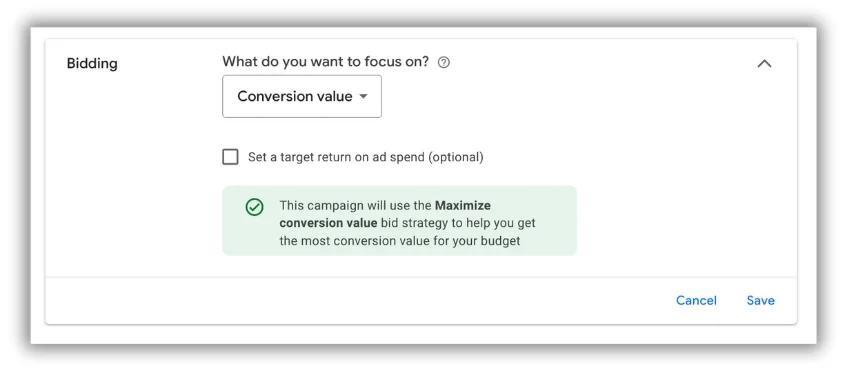
When to use it:
When to avoid it: If you do not track or assign values to your conversions.
You can start using Smart Bidding by navigating to your campaign settings and selecting one of the Smart Bidding options under the bidding section.
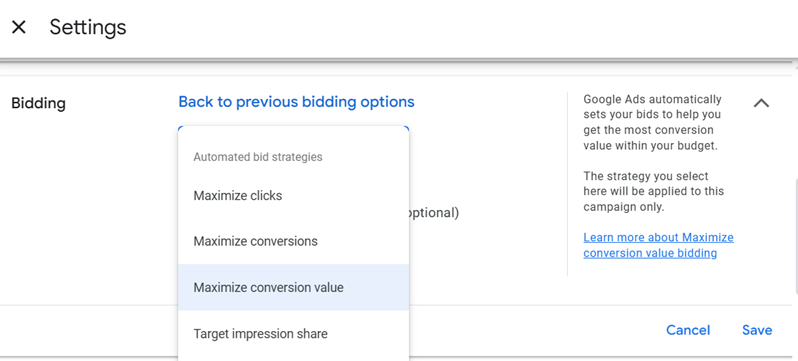
Note that depending on your campaign type, you may or may not see all four Smart Bidding options here.
Your conversion tracking, as well as your conversion value tracking, can be critical to your Smart Bidding success.
Choosing the right Smart Bidding strategy is crucial for achieving your goals. You may need to test a few strategies across campaigns.
Although Smart Bidding is automated, don’t just set it and forget it. Use Google Ads and Microsoft Ads reporting tools to track performance.
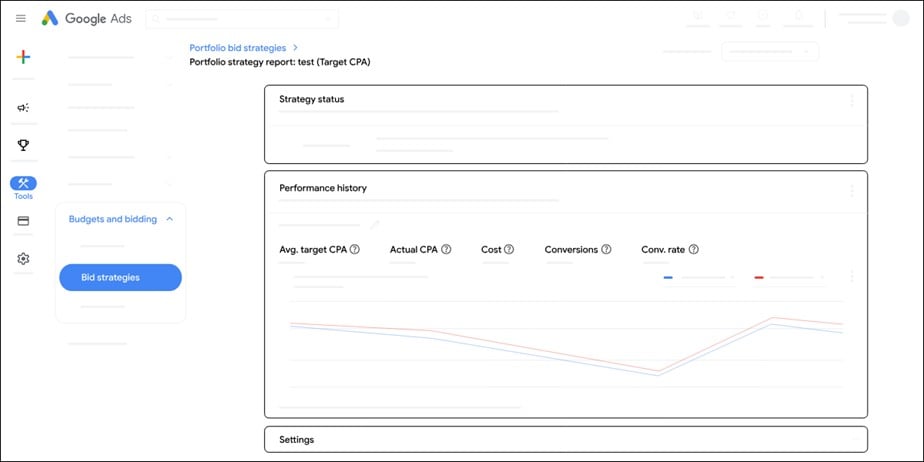
You can use Google Ads bid strategy reports to measure your Smart Bidding success.
Choosing the right Smart Bidding strategy in Google Ads is crucial for achieving your campaign goals. Whether you’re focused on controlling costs, maximizing revenue, or driving traffic, Google Ads’ Smart Bidding options provide a range of automated solutions to fit your needs.
By understanding these strategies and when to apply them, you can leverage Google’s automation to improve performance and achieve specific business objectives.
Now, use these Google Ads trends and these manual bidding tips to help you succeed. Also, be sure to check out how our solutions can help you transform your Smart Bidding strategies into high-powered goal crushers for your business.
